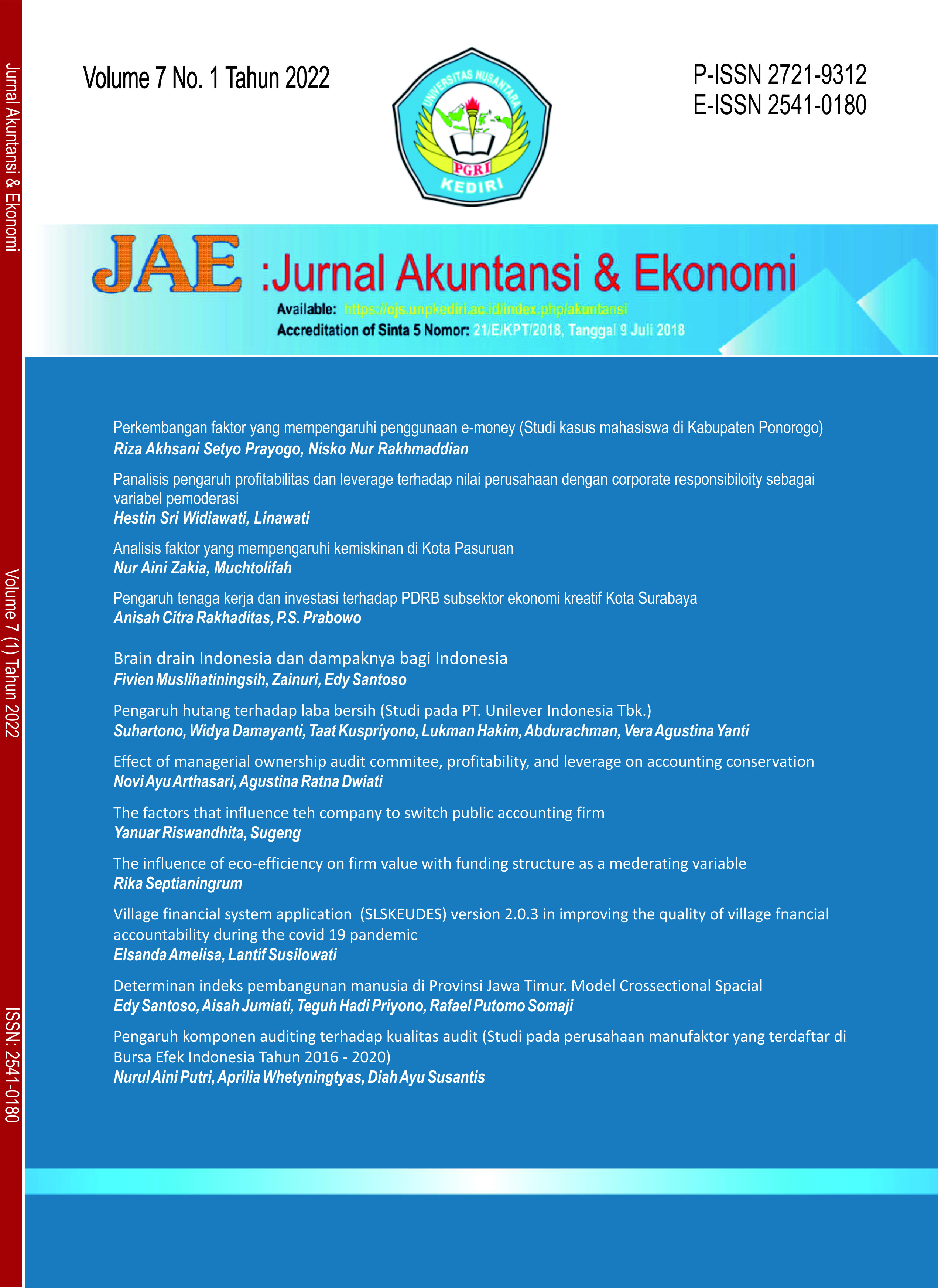Brain Drain Indonesia dan Dampaknya Bagi Indonesia
DOI:
https://doi.org/10.29407/jae.v7i1.17702Keywords:
Brain Drain, Per Capita Income, National securityAbstract
The purpose of this study is to analyze the effect of per capita income and the level of security in Singapore, Thailand and Malaysia on the brain drain of Indonesia and to find out how the impact of brain drain on Indonesia. The research method used is descriptive quantitative and uses panel data regression analysis. Based on the model specification test that has been carried out using the Chow test and the Hausman test, both suggest using the fixed effect model. The results show that the per capita income of Singapore, Malaysia and Thailand has a negative and significant effect on Indonesia's brain drain. The income of the destination area is a pull factor for the occurrence of brain drain, but if the government has increased domestic wages, it can reduce brain drain. The level of security in Singapore, Thailand and Malaysia has a negative and insignificant effect on brain drain in Indonesia, although the level of security is high in these countries, it does not necessarily guarantee legal protection for Indonesian workers who work there. If the brain drain continues, it will have a bad impact on Indonesia. Indonesia will lack a highly educated, expert or skilled workforce, so that Indonesia will be left far behind other countries in terms of economy, social and knowledge. For this reason, policies that support the development of domestic human resources are needed.
References
Basuki, A. T., & Prawoto, N. (2016). Analisis Regresi Dalam Penelitian Ekonomi & Bisnis (Dilengkapi Aplikasi SPSS & Eviews). Jakarta: PT Raja Grafindo Persada.
BPS. 2020. Profil Migran Hasil Survei Sosial Ekonomi Nasional 2019. https://www.bps.go.id/publication/2020/12/02/725d484ca73434e95d4d4b9d/profil-migran-hasil-survei-sosial-ekonomi-nasional-2019.html akses 20 des 2021
Cahyaningtyas. June. 2011. Brain Drain di Indonesia. Paradigma. Jurnal Masalah Sosial, Politik dan Kebijakan. Vol. 15, No. 2. DOI: https://doi.org/10.31315/paradigma.v15i2.2448
Elisa, Irukawa. 2017. Ancama Brain Drain Jika Kaum Intelektual Menetap di Negara Maju. https://www.duniadosen.com/ancaman-brain-drain/ Diakses 20 Oktober 2021.
Faiz, Pan Mohammad. 2007. BRAIN DRAIN dan SUMBER DAYA MANUSIA INDONESIA: Studi Analisa terhadap Reversed Brain Drain di India. Konferensi Internasional Pelajar Indonesia. https://adoc.pub/brain-drain-dan-sumber-daya-manusia-indonesia-studi-analisa-.html diakses 20 Oktober 2021
Fivien. M,. Sinaga, Juan Palem,. 2020. Migrasi Internasional Penduduk Pulau Jawa Menjadi Pekerja Migran Indonesia di Luar Negeri. Jurnal Ekonomi Pembangunan. Vol.9, No.2. https://doi.org/10.23960/jep.v9i2.100
Haris, Abdul. 2001. Migrasi Internasional, Jaminan Perlindungan, Dan Tantangan Ekonomi Global. Populasi: Jurnal Kependudukan dan Kebijakan Universitas Gajah Mada. Vol 12, No 1 (2001). https://doi.org/10.22146/jp.12272
Juwita Asmara. Indri. 2020. Intellectual Migration: Brain Drain, Brain Gain, and Brain Circulation. http://lipi.go.id/publikasi/intellectual-migration-brain-drain-brain-gain-and-brain-circulation/39249
Krasulja, Nevena & Blagojevic. (2016). Brain-Drain the Positive and Negative Aspects of the Phenomenon. Ekonomika, Journal for Economic Theory and Practice and Social Issues, Society of Economists Ekonomika, Nis, Serbia, vol. 62(3), September. DOI: 10.22004/ag.econ.289223
Mas’ad, dkk. 2016. Mengidentifikasi Faktor Yang Mempengaruhi Peningkatan Migrasi Internasional Di Desa Mekar Damai Kecamatan Praya Kabupaten Lombok Tengah Tahun 2015. Paedagoria, , Vol. 13, No. 1 April 2016 DOI: https://doi.org/10.31764/paedagoria.v7i1.178
Noveria, Mita. (2017). Migrasi Berulang Tenaga Kerja Migran Internasional: Kasus Pekerja Migran Asal Desa Sukorejo Wetan, Kabupaten Tulungagung . Jurnal Kependudukan Indonesia | Vol. 12 No. 1 Juni 2017 DOI: https://doi.org/10.14203/jki.v12i1.255
Rospriandana, Naufal. 2015. Brain Drain. Melihat & Belajar dari India. Mata Garuda Institute Bulletin. Edisi 5, Desember 2015. https://issuu.com/matagarudainstitute/docs/mata_garuda_institute_bulletin_edis
Rachmawati, Laksmi., dkk. 2021. Migrasi Tenaga Kerja Internasional: Investasi Sumber Daya Manusia dan Peningkatan Daya Saing. http://lipi.go.id/publikasi/migrasi-tenaga-kerja-internasional-investasi-sumber-daya-manusia-dan-peningkatan-daya-saing/27074 diakses 29 november 2021
Teguh, D dan Faizal, R.M. 2020. Intragenerational Economic Mobility In Indonesia: A Transition From Poverty To The Middle Class In 1993–2014. Bulletin of Indonesian Economic Studies, Vol. 56, No. 2, 2020. DOI: https://doi.org/10.1080/00074918.2019.1657795
Wahyudi, Ridwan. 2015. Mengenal Teori-teori Migrasi Pekerja Internasional. https://buruhmigran.or.id/2015/08/18/mengenal-teori-teori-migrasi-pekerja-internasional/. Diakses pada 20 Oktober 2021.
World Bank. Pekerja Global Indonesia: Antara Peluang dan Resiko. https://documents1.worldbank.org/curated/en/820641511876199851/pdf/121691-WP-P159694-PUBLIC-IndonesiasGlobalWorkersJugglingOpportunitiesRisks-BAHASA-INDONESIAN.pdf. Diakses 20 Des 2021
Yunitasari, Duwi. 2021. The Implication Of Brain Gain On Brain Drain Phenomenon In OvercomingThe Problem Of Educated Unemployment In Indonesia. Sosiohumaniora: Jurnal Ilmu-ilmu Sosial dan Humaniora. Vol, 23, No. 1, March 2021: 133-140. DOI: 10.24198/sosiohumaniora.v23i1.26749
Yuniarto, Paulus Rudolf. 2012 Dari Pekerja ke Wirausaha: Migrasi Internasional, Dinamika Tenaga Kerja, dan Pembentukan Bisnis Migran Indonesia di Taiwan. Jurnal Kajian Wilayah, Vol. 3, No. 1, 2012. DOI: https://doi.org/10.14203/jkw.v3i1.312
Yogi S. dan Dudy H. 2017. Kebijakan Migrasi Lintas Negara Pemerintah Indonesia (Studi Kasus Pengiriman Tenaga Kerja Indonesia Ke Malaysia). Jurnal Wacana Kinerja, Vol. 20,No. 2. November 2017. DOI: DOI:10.31845/jwk.v20i2.20
Downloads
Published
Issue
Section
License
Authors who publish with this journal agree to the following terms:
- Copyright on any article is retained by the author(s).
- The author grants the journal, right of first publication with the work simultaneously licensed under a Creative Commons Attribution License that allows others to share the work with an acknowledgment of the work’s authorship and initial publication in this journal.
- Authors are able to enter into separate, additional contractual arrangements for the non-exclusive distribution of the journal’s published version of the work (e.g., post it to an institutional repository or publish it in a book), with an acknowledgment of its initial publication in this journal.
- Authors are permitted and encouraged to post their work online (e.g., in institutional repositories or on their website) prior to and during the submission process, as it can lead to productive exchanges, as well as earlier and greater citation of published work.
- The article and any associated published material is distributed under the Creative Commons Attribution-ShareAlike 4.0 International License







